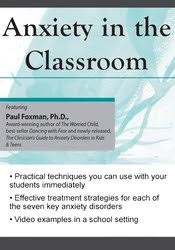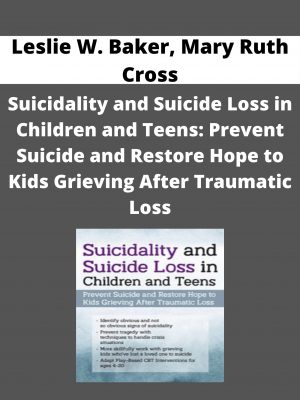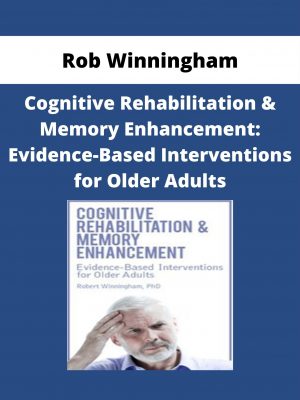Paul Foxman – Anxiety in the Classroom
$200 Original price was: $200.$75Current price is: $75.
Shopping Instructions:
- DISCOUNT 15% : SHOP15
- Product Delivery: Within 1 – 12 hours after purchase.
The increasing rate of stress and trauma to children, which includes divorce, global terrorism and violence, extensive technology use, media overload, bullying and diversity issues, has produced a “shell shocked” generation of students struggling to manage their anxiety.
Paul Foxman – Anxiety in the Classroom
- Practical techniques you can use with your students immediately
- Effective treatment strategies for each of the seven key anxiety disorders
- Video examples in a school setting
The increasing rate of stress and trauma to children, which includes divorce, global terrorism and violence, extensive technology use, media overload, bullying and diversity issues, has produced a “shell shocked” generation of students struggling to manage their anxiety. The challenge for those working in schools is to recognize the increasing anxiety level in students and help them cope.
Dr. Paul Foxman will teach you how, why and when anxiety develops in young people. The various manifestations for anxiety will be described, so that anxious students can be recognized and supported. Dr. Foxman will help you distinguish between normal anxiety and anxiety disorders, and give you a principle for making this distinction in school settings. Most importantly, you will learn practical strategies that can be applied immediately in the classroom setting and schools to reduce anxiety, enhance teaching effectiveness, and promote maximum learning.
- Design effective strategies to decrease the stress response in kids with learning disabilities to improve information processing, listening skills, and comprehension.
- Summarize the different ways anxiety manifests in the classroom (worry, social isolation, attention deficits, etc.) and determine the appropriate strategy for reducing symptoms.
- Implement a three-step skill building model for stress management among young clients.
- Utilize classroom friendly calming and relaxation activities to keep students engaged.
- Determine the signs of normal anxiety vs anxiety disorders to enhance teaching effectiveness.
- Evaluate the impact deep breathing exercises have on anxiety to enable task completion in the classroom.
Would you like to receive Paul Foxman – Anxiety in the Classroom ?
Nature and Causes of Anxiety
- How, when and why anxiety develops in children
- The anxiety temperament (biological sensitivity)
- The “anxiety personality” – assets and liabilities
- The role of stress in anxiety
How Anxiety Manifests in the Classroom
- Perfectionism
- Worry
- Task avoidance
- Restlessness and hyperactivity
- Attention deficits
- School avoidance
- Social isolation
- Depression and withdrawal
- Fatigue and low energy
- Low motivation
- Disorganization and poor time management
- Academic inconsistency or decline
- Learning disabilities
- Behavior problems
Seven Key Anxiety Disorders: Symptoms and Case Examples
- Separation anxiety disorder
- Panic disorder
- Generalized anxiety disorder
- Obsessive-compulsive disorder
- Social anxiety disorder (including selective mutism)
- Phobias
- Post-traumatic stress disorder
Classroom Interventions
- Assessing stress level in students
- 3-S approach to stress management (signs, sources and skillful solutions)
- Focusing the mind for learning
- Classroom friendly calming and relaxation activities
- Encouraging “flow”
- Mindfulness strategies
- Relationship building with anxious students
- Tips for reducing test anxiety
- Creating calm in the classroom
- 3 questions: intervention for anxious parents
- “Responsive Classroom”: applications and research findings
- Risk management with high-conflict divorce families
- Managing technology use in and out of school
- Best approach to bullying
- Anxiety curriculums for schools (friends for life, lifeskills)
- Special considerations for preschoolers
- Behavioral health recommendations
- How to be a role model for low stress and anxiety
Limitations of Research and Potential Risks
- Consider scope of practice
- Empirical and anecdotal evidence
- No “one size fits all” for any modality of anxiety treatment
Related products
HEALTH & MEDICAL
HEALTH & MEDICAL
HEALTH & MEDICAL
HEALTH & MEDICAL
Dr. J.E. Williams & Kevin Gianni – How to Read Your Blood Tests
HEALTH & MEDICAL
HEALTH & MEDICAL
Bernadette Giorgi – Attitude Ballet & Pilates Fusion – Just B Method
HEALTH & MEDICAL












